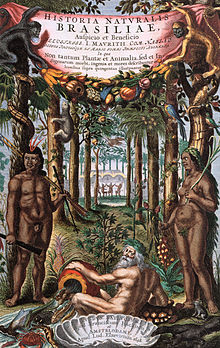Joannes de Laet
Joannes or Johannes De Laet (Latinized as Ioannes Latius) (1581 in
Life

De Laet was born in Antwerp between September and December 1581, a son of cloth merchant Hans De Laet. In 1584, upon the fall of Antwerp to Spanish troops, the family, like tens of thousands of Protestant Flemings, fled to the Northern Netherlands and settled in
In his leisure time, De Laet spent much of his time in his study room, well-stocked with books, manuscripts, maps, globes and paintings. He published widely on topics ranging from church history to world history. He played a crucial role in the 1648 publication of
De Laet died in December 1649 while in The Hague. He was buried in the Pieterskerk in Leiden on the 14th, next to Maria Boudewijns who had died in 1633.
Works
History of the New World
His History of the New World was published in several editions by Bonaventure & Abraham Elseviers, Leiden. The first edition was published in Dutch in 1625 as Nieuwe Wereldt ofte Beschrijvinghe van West-Indien, uit veelerhande Schriften ende Aen-teekeningen van verscheyden Natien;[2] a second edition also in Dutch, came out in 1630 as Beschrijvinghe van West-Indien door Joannes De Laet. Tweede druk: In ontallycke placesen verbetert, vermeerdert, met eenige nieuwe caerten, beelden van verscheijden dieren ende planten verciert.[3]
A Latin edition from 1633, prepared by himself, was entitled Novus Orbis seu descriptionis Indiae Occidentalis Libri XVIII authore Joanne De Laet Antverp. Novis tabulis geographicis et variis animantium, Plantarum Fructuumque iconibus illustrata;[4] in 1640 he published a French edition, in his own translation, as L'Histoire du Nouveau Monde ou description des Indes Occidentales, contenant dix-huict livres, enrichi de nouvelles tables geographiqiues & figures des animaux, plantes & fruicts.[5]
Each successive edition had significantly updated maps.
Other works
- The Empire of the Great Mogul, translated by J.S. Hoyland with S.N. Bannerjee. Taraporevela, Bombay, 1928. Reissued Munshiram Manoharlal, New Delhi, 1975, ISBN 81-7069-041-2.
- "Persia" (Latin: Persia seu Regni Persici Status Variaque Itinera in atque per Persiam : cum Aliquot Iconibus Incolarum), LVGD. BATAV. ex officina Elzeviriana, Anna MDCXXXIII (1633).
Notes and references
Notes
- ^ Neil Safier, "Beyond Brazilian Nature: The Editorial Itineraries of Marcgraf and Piso's Historia Naturalis Brasiliae" in Michiel Van Groesen, The Legacy of Dutch Brazil, New York: Cambridge University Press 2014, 169, 176.
- ^ Nieuwe Wereldt ofte Beschrijvinghe van West-Indien, uit veelerhande Schriften ende Aen-teekeningen van verscheyden Natien (Leiden, Bonaventure & Abraham Elseviers, 1625)
- ^ Beschrijvinghe van West-Indien door Joannes De Laet. Tweede druk: In ontallycke placesen verbetert, vermeerdert, met eenige nieuwe caerten, beelden van verscheijden dieren ende planten verciert. Archived 2004-12-27 at the Wayback Machine
- ^ Novus Orbis seu descriptionis Indiae Occidentalis Libri XVIII authore Joanne de Laet Antverp. Novis talulis geographicis et variis animantium, Plantarum Fructuumque iconibus illustrati, Lugd. Batav. apud Elzevirios 1633
- ^ L'Histoire du Nouveau Monde ou description des Indes Occidentales, contenant dix-huict livres, enrichi de nouvelles tables geographiqiues & figures des animaux, plantes & fruicts Archived 2004-12-27 at the Wayback Machine
References
- J. A. F. Bekkers, Correspondence of John Morris with Johannes de Laet (1634–1649) (Assen, 1970).
- Rolf H. Bremmer Jr and P. G. Hoftijzer, eds., Johannes de Laet (1581-169): A Leiden Polymath, special issue of Lias. Sources and Documents Relating to the Early Modern History of Ideas, vol. 25/2 (1998), 135–229, with contributions on the contents of his scholarly correspondence, his role in the Synod of Dort, his polemics with Hugo Grotius on the origin of the Native Americans, on his personal library, and on his Vitruvius edition.
- Rolf H. Bremmer Jr, '"Mine is Bigger than Yours": The Anglo-Saxon Collections of Johannes de Laet (1581-1649) and Sir Symonds D'Ewes', Anglo-Saxon Books and Their Readers, ed. Thomas N. Hall and Donald Scragg (Kalamazoo, MI, 2008), 136–174.
- Oxford Dictionary of National Biography
- Genealogical date from Descendants of Johannes de Laet (in Dutch)
External links
- Tierra Firma item Nuevo Reyno de Granada atque Popayan, a map of New Granada from L'Histoire du Nouveau Monde...
- Map of New England, 1624
- Open Library. Joannes de Laet 1593 - 1649
